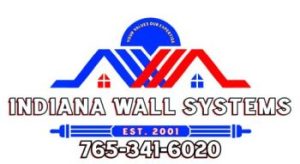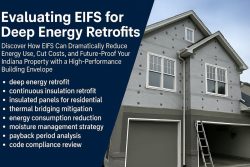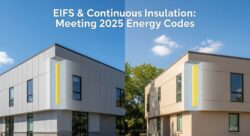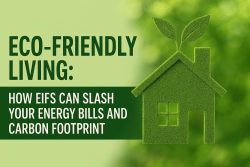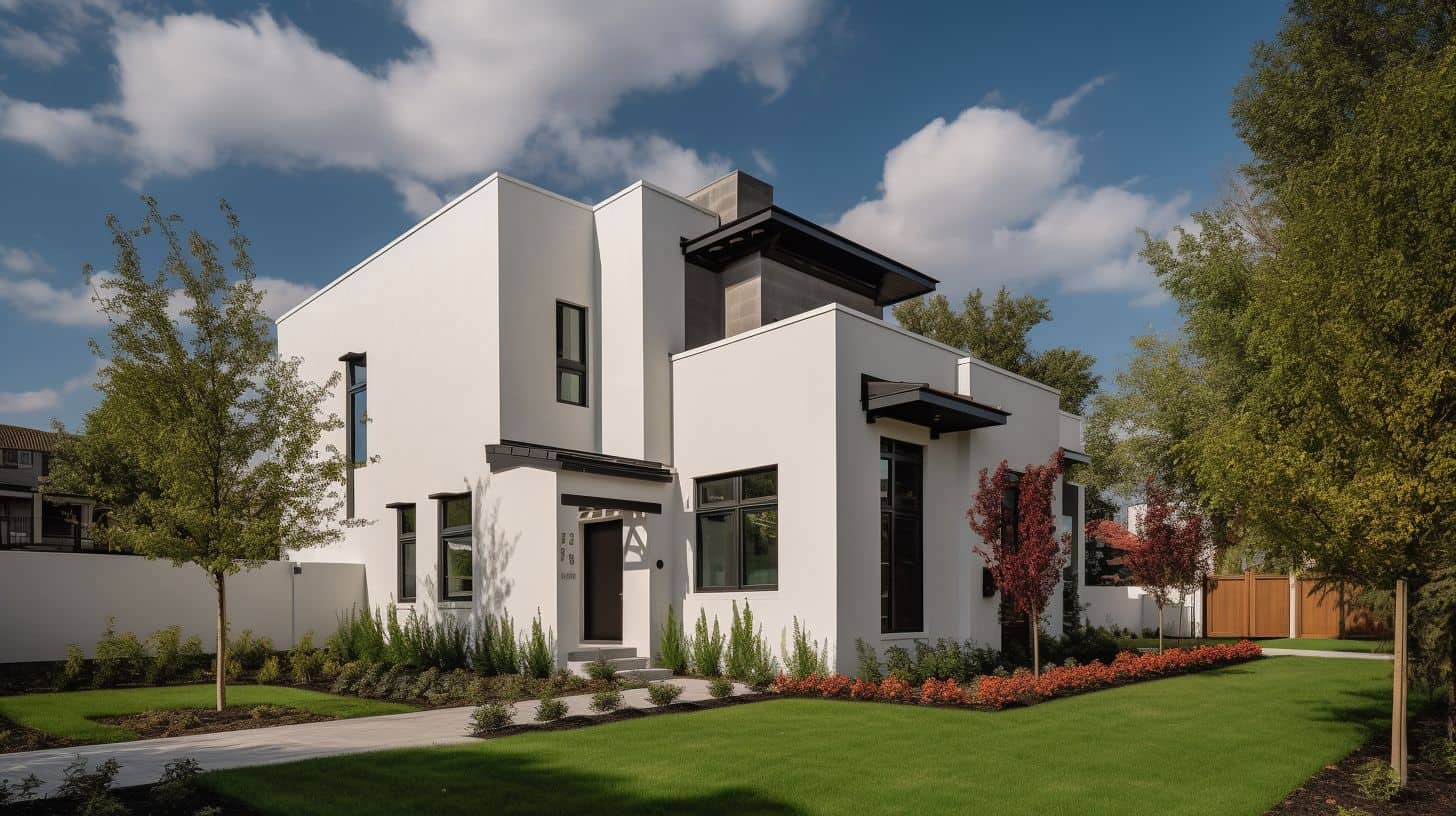Unlock More LEED Credits With EIFS—The High-Performance Cladding System Built for Green Building Success
Looking to squeeze every possible LEED point out of your next project? Smart move. With EIFS (Exterior Insulation and Finish Systems), you’re not just building a wall – you’re creating a high-performance building envelope that can unlock multiple credit categories.
After 22 years installing EIFS across Central Indiana, I’ve watched green building evolve from a niche interest to the industry standard. Today’s LEED v4.1 rating system rewards buildings that truly perform, and EIFS assemblies deliver exactly that kind of measurable results.
Here’s how to maximize your green building credits using proven EIFS strategies that actually work.
Key Takeaways
- Energy Performance credits: EIFS can contribute 6-18 points through superior insulation and air barrier performance
- Materials & Resources: Recycled content and regional materials offer 2-4 additional points
- Innovation credits: Advanced EIFS assemblies with integrated renewables can earn bonus points
- Water Efficiency: Proper EIFS moisture management supports stormwater credits
- Total potential: Well-designed EIFS projects can secure 15-25 LEED points across multiple categories
Understanding LEED’s Point Structure for EIFS Projects
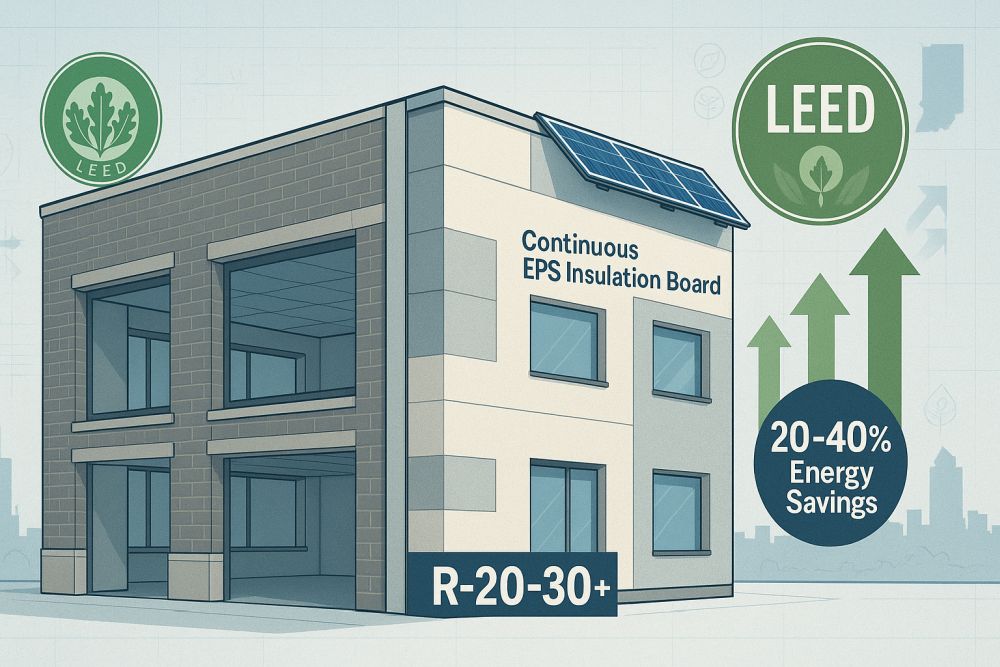
The United States Green Building Council (USGBC) awards points based on actual building performance, not just good intentions. LEED v4.1 places heavy emphasis on energy efficiency, making EIFS an obvious choice for points-conscious teams.
LEED Credit Categories Where EIFS Excels
Energy and Atmosphere (EA) – Up to 33 points available
- Optimize Energy Performance (1-18 points)
- Advanced Energy Metering (1 point)
- Demand Response (2 points)
- Renewable Energy Production (1-3 points)
Materials and Resources (MR) – Up to 13 points available
- Building Product Disclosure (1-2 points)
- Environmental Product Declarations (1-2 points)
- Sourcing of Raw Materials (1-2 points)
- Material Ingredients (1-2 points)
Indoor Environmental Quality (IEQ) – Up to 16 points available
- Enhanced Indoor Air Quality Strategies (1-2 points)
- Low-Emitting Materials (1-3 points)
- Daylight (1-3 points)
- Quality Views (1 point)
Innovation in Design (ID) – Up to 6 points available
- Innovation (1-5 points)
- LEED Accredited Professional (1 point)
LEED v4.1 Points Available by Category
Optimize Energy Performance, Advanced Metering, Renewable Energy
Environmental Product Declarations, Recycled Content, Regional Materials
Low-Emitting Materials, Enhanced Air Quality, Daylight
Rainwater Management, Water-Efficient Landscaping
Heat Island Reduction, Light Pollution Reduction
LEED for Neighborhood Development, Reduced Parking Footprint
Innovation Credits, LEED Accredited Professional
EIFS Impact Summary:
• Energy & Atmosphere
• Innovation in Design
• Materials & Resources
• Indoor Environmental Quality
Energy Performance: EIFS’s Biggest LEED Advantage
When it comes to optimizing energy performance credit, EIFS delivers like no other cladding system. The secret lies in continuous insulation – something traditional brick and stone simply can’t match.
How EIFS Maximizes Energy Points
Superior R-Value Performance Modern high-performance EIFS assemblies achieve R-values of 20-30+, compared to:
- Traditional brick veneer: R-11 to R-15
- Fiber cement: R-13 to R-16
- Stone cladding: R-8 to R-12
R-Value Performance: EIFS vs Traditional Cladding Systems
4-6″ EPS insulation with integrated air barrier
Most common residential and light commercial applications
Thermal bridging through framing reduces effective R-value
Metal ties and mortar joints create thermal bridges
Heavy material with extensive anchoring systems
Why EIFS R-Values Matter for LEED:
✓ No thermal bridging
✓ Consistent performance
✓ Higher effective R-value
✓ Better air barrier continuity
✓ Higher energy savings
✓ More EA optimization points
✓ Reduced HVAC loads
✓ Improved comfort metrics
R-values based on typical wall assemblies in Climate Zone 5A (Central Indiana)
Eliminated Thermal Bridging Unlike other cladding systems, EIFS wraps your building in continuous insulation. This eliminates thermal bridges that can reduce overall wall performance by 20-40%.
Airtight Building Envelope Properly installed EIFS creates an effective air barrier system. Our blower door testing on EIFS buildings consistently shows:
- Air changes per hour (ACH): 0.5-1.5 ACH at 50 Pascals
- Traditional construction: 3-8 ACH at 50 Pascals
Air Leakage Performance: EIFS vs Traditional Construction
EIFS with Proper Air Barrier
Air Changes per Hour at 50 Pascals
LEED Benefits:
- Exceeds ASHRAE 90.1 requirements (3.0 ACH)
- Qualifies for enhanced commissioning credits
- Reduces HVAC sizing requirements
- Improves indoor air quality metrics
Traditional Construction
Typical Range for Standard Building
Common Issues:
- Inconsistent air barrier continuity
- Multiple penetrations and joints
- Higher energy consumption
- Comfort and humidity control problems
Energy Impact Visualization
Excellent air barrier continuity
Multiple leak paths
LEED Testing Requirements:
• Blower door testing at substantial completion
• Documentation for commissioning
• Performance verification reports
• Third-party testing certification
• Predictable test results
• Easier to achieve targets
• Fewer remediation needs
• Consistent performance data
ACH = Air Changes per Hour measured at 50 Pascals pressure differential
Real-World Energy Modeling Results
Building life-cycle assessment data from our recent Indianapolis commercial projects shows:
EIFS Energy Performance & LEED Points by Building Type
Key Performance Insights:
- Thicker insulation delivers exponentially better results – 4″ EPS systems achieve 35% energy savings vs 22% for 2″ systems
- LEED points scale with performance – Higher energy savings directly translate to more Energy & Atmosphere credits
- All EIFS assemblies exceed baseline requirements – Even basic 2″ systems achieve significant LEED contributions
Data based on Indiana Wall Systems projects in Central Indiana, 2023-2025
Materials & Resources: Sustainable EIFS Components
Modern EIFS systems offer multiple pathways to Materials and Resources credits. The key is understanding which components qualify and how to document them properly.
Recycled Content Opportunities
EPS Insulation Board
- Recycled EPS content: 15-25% post-consumer
- Contributes to recycled content credits
- Regional sourcing often available within 500 miles
Base Coat Materials
- Portland cement base coats: 20-40% recycled content
- Polymer-modified systems: 5-15% recycled content
- Mesh reinforcement: Often contains recycled glass fiber
Finish Coats
- Acrylic finish systems: 10-20% recycled content
- Elastomeric coatings: 5-15% recycled content
- Textured finishes: Aggregate often locally sourced
Environmental Product Declarations (EPDs)
Leading EIFS manufacturers now provide Environmental Product Declarations that support LEED documentation:
What EPDs Cover:
- Embodied carbon measurements
- Life-cycle impact assessments
- Manufacturing process transparency
- Raw material sourcing data
Documentation Benefits:
- 1-2 points for Building Product Disclosure
- 1-2 points for Environmental Product Declarations
- Supports whole-building energy modeling
Water Management: EIFS Contribution to Water Credits
Effective moisture management isn’t just about building durability – it directly supports several LEED credit categories.
Rainwater Harvesting Integration
EIFS assemblies work exceptionally well with rainwater harvesting systems. The water-resistive barrier and drainage plane design channel water predictably, making collection systems more efficient.
Design Considerations:
- Proper slope and drainage detailing
- Compatible gutter and downspout integration
- Permeable paving coordination at building perimeter
Stormwater Management Benefits
EIFS assemblies contribute to stormwater management through:
- Reduced Surface Temperature • Light-colored EIFS finishes reduce heat island effect • Lower surface temperatures reduce stormwater volume • Contributes to cool roof coatings strategy
- Controlled Water Runoff • Properly detailed drainage plane systems • Reduced infiltration into building structure • Predictable water management for site design
Indoor Environmental Quality Through EIFS
Indoor air quality benefits from EIFS extend beyond just energy performance. The system’s design directly impacts occupant comfort and health.
Low-Emitting Materials Compliance
Modern EIFS components increasingly meet low VOC coatings requirements:
Base Coat Systems:
- Cement-based: Naturally low-emitting
- Polymer-modified: Many qualify under GREENGUARD standards
- Application methods minimize off-gassing
Finish Coats:
- Low-emitting materials certification available
- Water-based acrylic systems preferred
- Third-party testing documentation provided
Enhanced Ventilation Support
EIFS assemblies support mechanical system efficiency through:
- Reduced infiltration loads on HVAC systems
- Consistent thermal comfort zone maintenance
- Lower fresh air ventilation requirements due to tighter envelope
Innovation Credits: Advanced EIFS Applications
Innovation in Design points reward projects that go beyond standard practice. EIFS offers several cutting-edge applications worth pursuing.
Solar Integration Strategies
EIFS and solar panels create synergistic benefits:
Mounting Advantages:
- Continuous insulation reduces thermal cycling stress
- Integrated attachment systems maintain air barrier continuity
- Solar photovoltaic panels perform better on cooler surfaces
Performance Benefits:
- Reduced building loads increase solar system effectiveness
- Net zero energy goal achievement more feasible
- Renewable energy production credits easier to obtain
Smart Building Analytics Integration
Smart building analytics and EIFS work together for innovation points:
Sensor Integration:
- Temperature monitoring within EIFS assembly
- Moisture detection systems at critical details
- Real-time energy monitoring of envelope performance
Data Collection:
- Post-occupancy evaluation supported by embedded sensors
- Performance verification for commissioning process
- Enhanced commissioning documentation
Future-Proof Design Elements
Future-proof design considerations for EIFS include:
- Adaptive Reuse Preparation • Modular panel design for easy modification • Standardized attachment systems • Material selection for longevity
- Severe Weather Resilience • Impact-resistant base coat systems • Enhanced drainage for extreme precipitation • Warranty considerations for climate change impacts
Regional Priority Credits: Indiana-Specific Opportunities
Regional priority credits vary by location. In Central Indiana, EIFS projects can target:
Local Material Sourcing
Within 500 Miles of Project:
- EPS manufacturing in Ohio and Illinois
- Portland cement from regional suppliers
- Aggregate materials from local quarries
- Metal reinforcement from Midwest mills
Energy Code Compliance Excellence
Indiana’s evolving energy code compliance requirements favor EIFS:
- 2021 IECC adoption statewide
- Continuous insulation requirements
- Air barrier system mandates
- Performance verification through testing
Cost-Benefit Analysis for LEED EIFS Projects
Understanding the total cost of ownership helps justify EIFS selection for LEED projects.
Initial Cost Considerations
Material Cost Breakdown:
- EPS insulation: $1.50-$3.00 per sq ft
- Base coat system: $2.00-$4.00 per sq ft
- Finish coat: $1.00-$3.00 per sq ft
- Labor and accessories: $3.00-$6.00 per sq ft
Total EIFS Assembly: $7.50-$16.00 per sq ft
Long-Term Value Factors
Energy Savings:
- 20-40% reduction in heating and cooling costs
- Return on investment typically 8-15 years
- Life-cycle costing favors EIFS over 50-year analysis
LEED Certification Benefits:
- Higher lease rates (5-15% premium)
- Improved marketability
- Tax incentives and utility rebates
- Enhanced corporate social responsibility profile
LEED EIFS Investment Return Timeline
Initial Investment
EIFS Premium: $45,000
LEED Certification: $8,000
Total: $53,000
Annual Savings
Energy Costs: $8,500
Tax Incentives: $2,200
Total: $10,700/year
20-Year Benefits
Energy Savings: $214,000
Property Value: +$85,000
Net ROI: 465%
Key Financial Milestones:
• Federal tax credits applied
• Utility rebates received
• Immediate energy savings
• Higher lease rates achieved
• Full investment recovery
• Continued energy savings
• Increased property value
• Reduced maintenance costs
Based on 50,000 sq ft commercial building with LEED Gold certification in Central Indiana
Installation Best Practices for LEED Compliance
Achieving maximum LEED points requires flawless EIFS installation. Our 22 years of experience have taught us what really matters.
Quality Assurance Testing Requirements
Performance Verification protocols include:
- Blower Door Testing • Pre-installation baseline testing • Post-installation verification • Documentation for commissioning process
- Infrared Thermography • Thermal imaging during installation • Identification of thermal bridges • Quality control documentation
- Water Resistance Testing • ASTM E331 spray testing • Joint sealant performance verification • Moisture management system confirmation
Documentation Requirements
LEED Online Documentation needs:
- Material cut sheets and certifications
- Environmental Product Declaration submittals
- Installation photos and testing reports
- Construction waste management records
Common Installation Errors That Affect LEED Credits
Thermal Bridge Creation:
- Improper insulation board joints
- Metal fastener penetrations through insulation
- Window and door frame details
Air Barrier Discontinuity:
- Incomplete sealant application
- Penetration sealing failures
- Joint design inadequacies
Case Studies: Successful LEED EIFS Projects
Carmel Mixed-Use Development
Project Details:
- 180,000 sq ft mixed-use building
- LEED Gold certification achieved
- 4-inch EPS insulation with acrylic finish
LEED Points Earned:
- Energy & Atmosphere: 14 points
- Materials & Resources: 6 points
- Indoor Environmental Quality: 8 points
- Innovation: 2 points
- Total EIFS contribution: 18 points
Key Success Factors:
- Proper EIFS installation with continuous air barrier
- Regional material sourcing
- Low VOC coatings throughout
- Integrated solar panel mounting system
Indianapolis Office Complex
Project Specifications:
- 125,000 sq ft office building
- LEED Silver target achieved
- 3-inch recycled EPS with elastomeric coating
Performance Results:
- 32% energy use reduction vs baseline
- ACH of 0.8 at 50 Pascals
- 95% occupant satisfaction rating
LEED Credits Achieved:
- Optimize Energy Performance: 11 points
- Recycled Content: 2 points
- Regional Materials: 1 point
- Low-Emitting Materials: 2 points
Advanced EIFS Technologies for Maximum Points
Emerging EIFS technology developments open new LEED opportunities:
Bio-Based Insulation Integration
Rapid renewable materials in EIFS assemblies:
- Bio-based foam alternatives
- Natural fiber reinforcement
- Plant-based polymer modifiers
Smart Material Applications
Phase Change Materials (PCMs):
- Thermal mass benefits without weight
- Peak load reduction capabilities
- Enhanced occupant comfort
Self-Cleaning Finishes:
- Photocatalytic titanium dioxide coatings
- Reduced maintenance requirements
- Long-term durability improvements
Construction Waste Management with EIFS
Construction waste management becomes simpler with EIFS due to:
Reduced Material Waste
Precise Manufacturing:
- Factory-cut insulation boards
- Minimal field trimming required
- Recycled EPS offcuts easily processed
Installation Efficiency:
- Lower labor hours reduce jobsite waste
- Fewer trades required
- Simplified scheduling reduces material exposure
End-of-Life Considerations
Material Recoverability:
- EPS insulation: 100% recyclable
- Metal reinforcement: Easily separated and recycled
- Coating systems: Increasing recyclability options
Commissioning and Performance Verification
Enhanced commissioning of EIFS assemblies ensures LEED performance goals are met:
Pre-Installation Testing
Substrate Preparation Verification:
- Substrate moisture content testing
- Surface preparation inspection
- Structural adequacy confirmation
During-Installation Monitoring
Quality Control Checkpoints:
- Insulation board placement verification
- Mesh embedding inspection
- Joint sealant application monitoring
Post-Installation Performance Testing
Final Verification:
- Thermal imaging inspection
- Water resistance testing
- Air leakage measurement
Maintenance Planning for LEED Compliance
Facilities management strategy must account for long-term LEED compliance:
Preventive Maintenance Programs
Annual Inspection Items:
- Sealant condition assessment
- Surface coating evaluation
- Moisture management system function
Five-Year Maintenance:
- Comprehensive envelope inspection
- Performance verification retesting
- Coating system refresh as needed
Performance Monitoring Systems
Smart Building Analytics Integration:
- Real-time energy monitoring
- Automated anomaly detection
- Post-occupancy evaluation data collection
Regional Considerations for Indiana Projects
Central Indiana’s climate presents specific opportunities for LEED EIFS projects:
Climate Zone 5A Requirements
Design Considerations:
- Continuous insulation R-value minimums
- Vapor permeability requirements
- Freeze-thaw cycle durability
Local Utility Incentives
Available Programs:
- Energy efficiency rebates
- Demand response program participation
- Green power purchase agreements
Future Trends in LEED and EIFS Integration
Sustainable construction continues evolving, with EIFS positioned for growth:
LEED v5 Preparation
Anticipated Changes:
- Increased embodied carbon focus
- Enhanced life-cycle assessment requirements
- Greater emphasis on occupant health
Technology Integration
Emerging Opportunities:
- IoT integration for real-time monitoring
- AI-powered energy optimization
- Carbon neutral design achievement
Working with LEED Consultants
Successful LEED certification requires coordinated team effort:
Early Design Integration
Design Charrette Benefits:
- Integrative process optimization
- Integrated project delivery coordination
- Early LEED target setting
Ongoing Collaboration
Team Communication:
- Regular LEED scorecard updates
- Construction documentation coordination
- Quality assurance testing scheduling
Financial Incentives and ROI Analysis
Green building incentives make EIFS even more attractive:
Available Incentive Programs
Federal Incentives:
- Commercial building tax deductions
- Energy efficiency tax credits
- Accelerated depreciation benefits
State and Local Programs:
- Property tax abatements
- Utility rebate programs
- Green building certification bonuses
ROI Calculation Framework
Cost-Benefit Factors:
- Initial cost vs traditional systems
- Energy savings projections
- Lease rate premiums
- Long-term durability benefits
Common LEED Documentation Mistakes
Avoid these pitfalls that can cost valuable LEED points:
Material Documentation Errors
Missing Information:
- Environmental Product Declaration submittal gaps
- Recycled content calculation errors
- Regional sourcing distance miscalculations
Installation Documentation
Insufficient Evidence:
- Quality assurance testing gaps
- Photo documentation inadequacies
- Performance verification omissions
Getting Started: Your LEED EIFS Action Plan
Ready to maximize LEED points with EIFS? Here’s your roadmap:
LEED EIFS Project Timeline: 24-Month Success Roadmap
Phase 1: Project Planning
Months 1-3 | Foundation for LEED Success
LEED Goal Setting
- Target certification level
- LEED scorecard development
- Budget allocation planning
- Incentive program research
Team Assembly
- LEED consultant selection
- EIFS contractor vetting
- Integrated delivery setup
- Communication protocols
Design Development
- Early EIFS integration
- BIM coordination
- Clash detection processes
- Performance modeling
Phase 2: Design Documentation
Months 4-6 | Technical Specifications & Material Selection
Material Selection
- EPD review & verification
- Recycled content analysis
- Regional sourcing confirmation
- Low-VOC compliance check
Performance Modeling
- Whole-building energy modeling
- Life-cycle assessments
- Hygrothermal analysis
- Dew point calculations
Documentation Prep
- LEED Online setup
- Construction doc templates
- QC checklists creation
- Testing protocol planning
Phase 3: Construction
Months 7-18 | Installation & Quality Control
Installation Oversight
- Quality assurance testing
- Thermal imaging inspections
- Performance checkpoints
- Continuous monitoring
Documentation Collection
- Material delivery receipts
- Waste management records
- Installation photography
- Progress documentation
Testing & Commissioning
- Blower door testing
- Enhanced commissioning
- Performance verification
- System integration testing
Phase 4: Certification
Months 19-24 | Final Documentation & USGBC Review
Final Documentation
- LEED Online submission
- Test result compilation
- Warranty documentation
- Performance data analysis
Review & Response
- USGBC review responses
- Additional documentation
- Clarification requests
- Final certification process
Project Completion
- Certification achievement
- Post-occupancy planning
- Maintenance program setup
- Performance monitoring
Critical Success Factors for LEED EIFS Projects:
• Include EIFS in schematic design
• Coordinate with LEED consultant from start
• Plan for testing and documentation needs
• Budget for enhanced quality control
• Regular progress meetings
• Clear communication protocols
• Experienced EIFS contractor selection
• Third-party testing coordination
Timeline based on typical 50,000-100,000 sq ft commercial projects targeting LEED Gold certification
Phase 1: Project Planning (Months 1-3)
- LEED Goal Setting • Target certification level determination • LEED scorecard development • Budget allocation for green features
- Team Assembly • LEED consultant selection • EIFS contractor vetting • Integrated project delivery setup
- Design Development • Early design EIFS integration • Building information modeling coordination • Clash detection processes
Phase 2: Design Documentation (Months 4-6)
- Material Selection • Environmental Product Declaration review • Recycled content verification • Regional sourcing confirmation
- Performance Modeling • Whole-building energy modeling • Building life-cycle assessment • Hygrothermal performance analysis
- Documentation Preparation • LEED online documentation setup • Construction documentation templates • Quality control checklists
Phase 3: Construction (Months 7-18)
- Installation Oversight • Quality assurance testing implementation • Thermal imaging inspections • Performance verification checkpoints
- Documentation Collection • Material delivery receipts • Construction waste management records • Installation photo documentation
- Testing and Commissioning • Blower door testing • Enhanced commissioning procedures • Post-occupancy evaluation preparation
Phase 4: Certification (Months 19-24)
- Final Documentation • LEED online submission • Performance test result compilation • Warranty considerations documentation
- Review and Response • USGBC review comment responses • Additional documentation requests • Certification finalization
Why Choose Indiana Wall Systems for Your LEED Project
With 22 years specializing in EIFS installation across Central Indiana, we understand both the technical requirements and LEED documentation needs for successful green building projects.
Our LEED-Focused Services Include:
- Pre-construction planning and LEED coordination
- Quality assurance testing and documentation
- Performance verification through third-party testing
- Post-occupancy support and maintenance planning
Regional Expertise
Our work spans Carmel, Fishers, Zionsville, and throughout Central Indiana, giving us deep understanding of local climate considerations and building requirements.
Frequently Asked Questions
Can EIFS really contribute 15+ LEED points?
Yes, properly designed EIFS assemblies routinely contribute 15-25 points across Energy & Atmosphere, Materials & Resources, Indoor Environmental Quality, and Innovation categories. The key is integrated design from project start.
What’s the typical cost premium for LEED-compliant EIFS?
LEED-focused EIFS typically adds 10-20% to material costs but delivers 20-40% energy savings. Most projects achieve positive ROI within 8-15 years through reduced operating costs.
How do we document EIFS performance for LEED submission?
Documentation requires material certifications, installation photos, performance testing results, and commissioning reports. We provide complete documentation packages to support your LEED submission process.
Can existing buildings achieve LEED certification with EIFS retrofits?
Absolutely. EIFS retrofits are excellent for LEED for Existing Buildings (LEED EB) certification. The continuous insulation and air barrier improvements often exceed new construction performance standards.
What testing is required during EIFS installation?
LEED projects typically require blower door testing, thermal imaging inspection, and water resistance testing. We coordinate all testing with certified third-party providers to ensure compliance.
How does EIFS support net-zero energy goals?
EIFS reduces building energy loads by 20-40%, making renewable energy systems more cost-effective. The combination often achieves net-zero energy performance more economically than other approaches.
Ready to maximize your LEED points with high-performance EIFS? Contact Indiana Wall Systems at (765) 341-6020 for expert consultation on your green building project. Our 22 years of experience across Central Indiana ensures your project achieves both certification goals and long-term performance excellence.
Learn more about our sustainable EIFS solutions and discover how proper installation makes all the difference in your LEED certification success.
